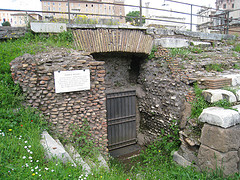 Image by rogue2408 via Flickr Image by rogue2408 via Flickr |
| Cloaca Maxima |
Large-scale collection of sewage began more than 2400 years ago with the construction of the Cloaca Maxima in Rome. The Dejecti Effusive Actio was one of the earliest sanitation laws, and it fined Romans who hurt passers-by when they tossed or poured their wastes into the streets. However, much of the Romans’ progress in sanitation was forgotten until the 19th century when modern waste treatment began.
Polio occurred in ancient Rome (some say Claudius was a victim, although this may be doubtful); it later largely disappeared in Europe and re-emerged in the 19th century (anecdotally supporting the sanitation hypothesis related to polio immunization).
The “Old Friends” hypothesis (circa 2003) has altered our interpretation of these phenomena. Increased density and circulation of the population in advanced societies may simply offer better interpersonal exposure to these pathogens that have always been present.





